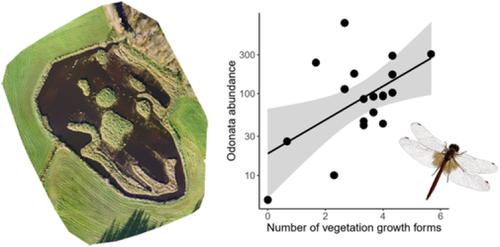当前位置:
X-MOL 学术
›
Insect Conserv. Divers.
›
论文详情
Our official English website, www.x-mol.net, welcomes your feedback! (Note: you will need to create a separate account there.)
Heterogenic aquatic vegetation promotes abundance and species richness of Odonata (Insecta) in constructed agricultural wetlands
Insect Conservation and Diversity ( IF 3.5 ) Pub Date : 2019-11-25 , DOI: 10.1111/icad.12396 Ida‐Maria Huikkonen 1 , Ilona Helle 1 , Merja Elo 1, 2
中文翻译:

异种水生植被促进人工农业湿地中的Odonata(Insecta)丰富和物种丰富
更新日期:2019-11-25
Insect Conservation and Diversity ( IF 3.5 ) Pub Date : 2019-11-25 , DOI: 10.1111/icad.12396 Ida‐Maria Huikkonen 1 , Ilona Helle 1 , Merja Elo 1, 2
Affiliation

|
- Natural wetlands are among the most threatened habitat types worldwide. They contain a high diversity of macroinvertebrates, including dragonflies and damselflies (Insecta: Odonata). In agricultural landscapes, new wetlands have been constructed to filter nutrients and solid matter from agricultural runoff. These types of wetlands may also benefit Odonata as new breeding habitats. However, it is not yet clear what environmental characteristics of constructed wetlands are important for Odonata.
- We studied 20 constructed agricultural wetlands in Central Finland and asked whether Odonata are able to use these wetlands as breeding habitats, and which environmental characteristics (aquatic vegetation, water area, shoreline length, bottom type diversity, water transparency, and pH) of the wetlands affect odonate abundance and species richness.
- The constructed wetlands hosted altogether 17 odonate species. Odonate abundance was positively associated with the number of aquatic vegetation growth forms of the wetland. Odonate species richness was associated positively with abundance, floating‐leaved vegetation, and water transparency.
- Constructed agricultural wetlands support local diversity of common odonate species. Although protecting the remaining natural wetlands is of primary importance, constructed wetlands can add suitable wetland habitats in the agricultural landscape. From the perspective of Odonata, heterogenic aquatic vegetation and water quality are features worth promoting when constructing and managing agricultural wetlands.
中文翻译:

异种水生植被促进人工农业湿地中的Odonata(Insecta)丰富和物种丰富
- 天然湿地是全球最受威胁的栖息地类型之一。它们包含多种多样的大型无脊椎动物,包括蜻蜓和豆娘(Insecta:Odonata)。在农业景观中,已经建造了新的湿地,以过滤掉农业径流中的养分和固体物质。这些类型的湿地也可能使Odonata成为新的繁殖栖息地。然而,尚不清楚人工湿地的环境特征对Odonata是否重要。
- 我们研究了芬兰中部的20个人工湿地,并询问Odonata是否能够将这些湿地用作繁殖栖息地,以及湿地的哪些环境特征(水生植被,水域,海岸线长度,底部类型多样性,水透明度和pH)影响卵酸盐的丰度和物种丰富度。
- 人工湿地共有17种odonate物种。Odonate丰度与湿地水生植被生长形式的数量呈正相关。齿形藻物种丰富度与丰富度,浮叶植被和水透明度呈正相关。
- 人工农业湿地支持常见的齿形物种的局部多样性。尽管保护剩余的自然湿地至关重要,但人工湿地可以在农业景观中增加合适的湿地栖息地。从Odonata的角度来看,异质性水生植被和水质是建设和管理农业湿地时值得推广的特征。


























 京公网安备 11010802027423号
京公网安备 11010802027423号